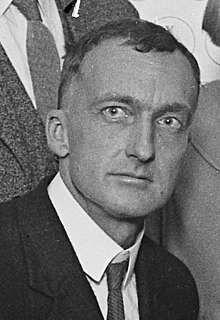John Peabody Harrington
John Peabody Harrington (April 29, 1884 – October 21, 1961) was an American linguist and ethnologist and a specialist in the indigenous peoples of California. Harrington is noted for the massive volume of his documentary output, most of which has remained unpublished: the shelf space in the National Anthropological Archives dedicated to his work spans nearly 700 feet.[1]
John P. Harrington | |
|---|---|
 Harrington in 1924 | |
| Born | April 29, 1884 |
| Died | October 21, 1961 (aged 77) San Diego, California |
| Education | Stanford University, UC Berkeley, University of Leipzig, University of Berlin, |
| Occupation | Linguist, Field ethnologist |
| Spouse(s) | Carobeth Laird |
Early life and education
Born in Waltham, Massachusetts, Harrington moved to California as a child. From 1902 to 1905, Harrington studied anthropology and classical languages at Stanford University. While attending specialized classes at the University of California, Berkeley, he met anthropologist Alfred L. Kroeber. Harrington became intensely interested in Native American languages and ethnography.
Linguistic legacy
.jpg)
Rather than completing his doctorate at the Universities of Leipzig and Berlin, Harrington became a high-school language teacher. For three years, he devoted his spare time to an intense examination of the few surviving Chumash people. His exhaustive work came to the attention of the Smithsonian Museum's Bureau of American Ethnology. Harrington became a permanent field ethnologist for the bureau in 1915. He was to hold this position for 40 years, collecting and compiling several massive caches of raw data on native peoples, including the Chumash, Mutsun, Rumsen, Chochenyo, Kiowa, Chimariko, Yokuts, Gabrielino, Salinan, Yuma, and Mojave, among many others. Harrington also extended his work into traditional culture, particularly mythology and geography. His field collections include information on placenames and thousands of photographs. The massive collections were disorganized in the extreme, and contained not only linguistic manuscripts and recordings, but also objects and realia of every stripe; a later cataloger described how opening each box of his legacy was "an adventure in itself."[2]
Harrington is virtually the only recorder of some languages, such as Obispeño (Northern) Chumash, Kitanemuk, and Serrano. He gathered more than 1 million pages of phonetic notations on languages spoken by tribes from Alaska to South America. When the technology became available, he supplemented his written record with audio recordings - many recently digitized[3] - first using wax cylinders, then aluminum discs. He is credited with gathering some of the first recordings of native languages, rituals, and songs, and perfecting the phonetics of several different languages.[4] Harrington's attention to detail, both linguistic and cultural, is well-illustrated in "Tobacco among the Karuk Indians of California," one of his relatively few formally published works.[5]
A more complete listing of the languages he documented includes:[6]
|
|
Personal life
Harrington was married to Carobeth Laird (née Tucker) from 1916–1923. They had one daughter, Awona Harrington.[7]
See also
- Indigenous languages of California
- Traditional narratives (Native California)
- Native American history of California
- Native Americans in California
- Survey of California and Other Indian Languages
References
- Glenn, James R. (1991). "The Sound Recordings of John P. Harrington: A Report on Their Disposition and State of Preservation". Anthropological Linguistics. 33 (4): 357–366. ISSN 0003-5483. JSTOR 30028216.
- Callaghan, C. A (1991). "Encounter with John P. Harrington". Anthropological Linguistics. 33 (4): 350–356.
- "Collections Search Center, Smithsonian Institution". collections.si.edu. Retrieved 16 May 2010.
- Krieger, Lisa M. (2007-12-23). "Long gone Native languages emerge from the grave: Millions of cryptic notes from linguist John Peabody Harrington". Mercury News. Retrieved 2007-12-30.
- Harrington, John P. 1932. "Tobacco among the Karuk Indians of California. Bureau of American Ethnology Bulletin 94. U.S. Government Printing Office, Washington.
- Victor Golla (2 August 2011). California Indian Languages. University of California Press. ISBN 978-0-520-26667-4.
- Laird, Carobeth. 1975. Encounter with an Angry God: Recollections of my Life with John Peabody Harrington. Malki Museum Press, Banning, CA.
External links
| Wikimedia Commons has media related to John Peabody Harrington. |
- J.P. Harrington Database Project
- Victor Golla, California Indian Languages (UC Press, 2011)
- Bibliography
- John Peabody Harrington: the clue to lost Native American languages: Mike Anton LA Times Staff Writer ()
- Keepers of Indigenous Ways: J.P. Harrington Biography
- "Reconstituting the Chumash: A Review Essay," Peter Nabokov, American Indian Quarterly, Vol. 13, No. 4, Special Issue: The California Indians. (Autumn, 1989), pp. 535-543.
- A Harrington Chronology
- John P. Harrington Papers 1907-1959 (some earlier)
- Los Angeles Times article and video about Harrington's research amongst the Chumash
- The John Peabody Harrington Collection at the National Anthropological Archives